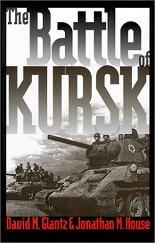
The Battle of Kursk
David M. Glantz & Jonathan M. House
472 pages including index and notes
published in 1999
Kursk is a name most people probably only know from that Russian submarine that sank some years ago. Much fewer people know what that submarine was named after: one of the bloodiest and most important battles of World War II. The Battle of Kursk was fought in 1943, the largest tank battle of the war and was the last battle in which the Germans had the strategic initiative. After Kursk it was the Russians who held the upper hand and the Germans who had to defend. What’s more it was the first battle in which the Russian forces managed to stop the German blitzkrieg
It’s also a battle loved by war nerds, as it got the German panzer army at its peak taking on endless waves of Russian T-34s and Su-76s on the endless steppes and is so much more interesting than the infantry slog of Stalingrad…
However much of what we used to know about Kursk has come from German sources, as Soviet archives have only come available since the end of the USSR. So it has always been about the heroic deeds of the panzer commanders against the endless Slavic hordes so to speak. The emphasis has largely been on the Germans plans for the battle, on what went wrong for them and especially in the memoirs of those particpated, how it was not their fault that the battle was lost but Hitler’s. The Battle of Kursk is one of the first books on the battle to make full use of Soviet archives as well as German ones, giving a much more complete picture of the battle.
The German invasion of the Soviet Russia in 1941 has everything going for it, with the Russians only stopping them when they were literally in the suburbs of Moscow. The following year the Germans renewed their offensive on a somewhat smaller scale, concentrating on the South and ultimately Stalingrad, which did not end well for them. For the Russians Stalingrad was a chance to gain the initiative amd they attempted to go on the offensive, with mixed results. Once the front stabilised there was a huge bulge in the frontline around Kursk, where the Russian forces had managed to penetrate the German lines, while a smaller German bulge was to the north of this, around Orel. Such bulges are both an opportunity to penetrate further, but also a danger as the enemy can pinch it off and destroy the forces within it.
In 1943 the German command decided that the Russian salient at Kursk needed to be gotten rid off. This would at the very least help shorten their frontline and make it more defensible, at best perhaps open up room to escape into the strategic depths beyond the frontline and deliver a crushing blow to the Russians. At the same time the German generals, as well as Hitler were realistic enough to know that their Russian counterparts would recognise the same potential and that even if they would get the outcome of the battle they wanted it would not be the end of the war. Originally they planned a May offensive, but the desire to have the new Panther and Tiger tanks available in mass as well as other considerations meant the battle only started on July 5.
And indeed the Russians had recognised the opportunity and made plans. Their idea was to let the Germans attack, absorb their blows, then launch their counteroffensive. To do so they erected massive defences in depth around Kursk surrounded by mine fields, manned by infantry armed with anti-tank rifles and anti-tank artillery as well dug in T-34s. Beyond that were the concentrated tank armies and beyond that even more reserves. In the end the Russians had an almost three to two superiority at Kursk.
Once the battle itself starts both German and Russian expectations are of course shattered. While the Germans get frustrated in their attempts to break through the Russian defences, the Russians have troubles containing the German assault, even with their numerical superiority. The Luftwaffe’s local air superiority on the first days of the battle does not help. In the end it’s as much the battles on the Germans’ flanks which prevents them from using their whole strength at front as it is the Russian counterattacks that stop the offensive.
Glantz and House tell the story of the battle with liberal extracts from both German and Russian sources. They follow the battle in detail, from day to day and even hour to hour on the critical fronts. This can get a bit tedious at times, but does work well in getting some of the flavour of the battle.
After the battle the Soviets took over the initiative from the Germans and immediately launched offensives against the German salient at Orel, as well as elsewhere. Though these did not yet have the succes that the summer offensives of a year later would have, they were still a disaster for the Germans, scrambling to defend themselves. In the end the battle turned out to be not so much a win for the Russians as a loss to the Germans, though they still had enough resiliance to avoid it becoming a total disaster…